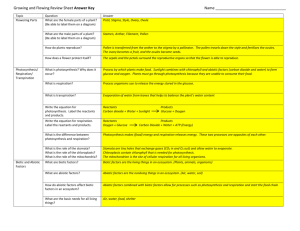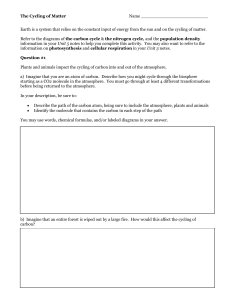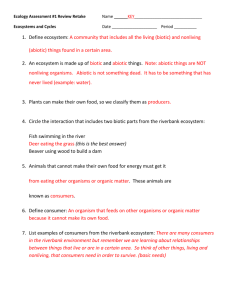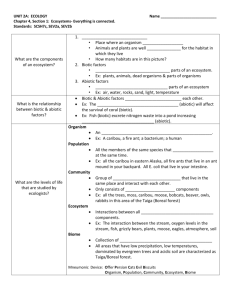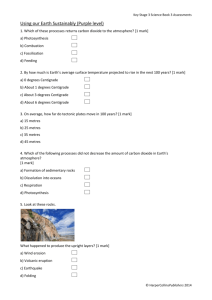SNC1P - Review for Ecology Unit Test
advertisement
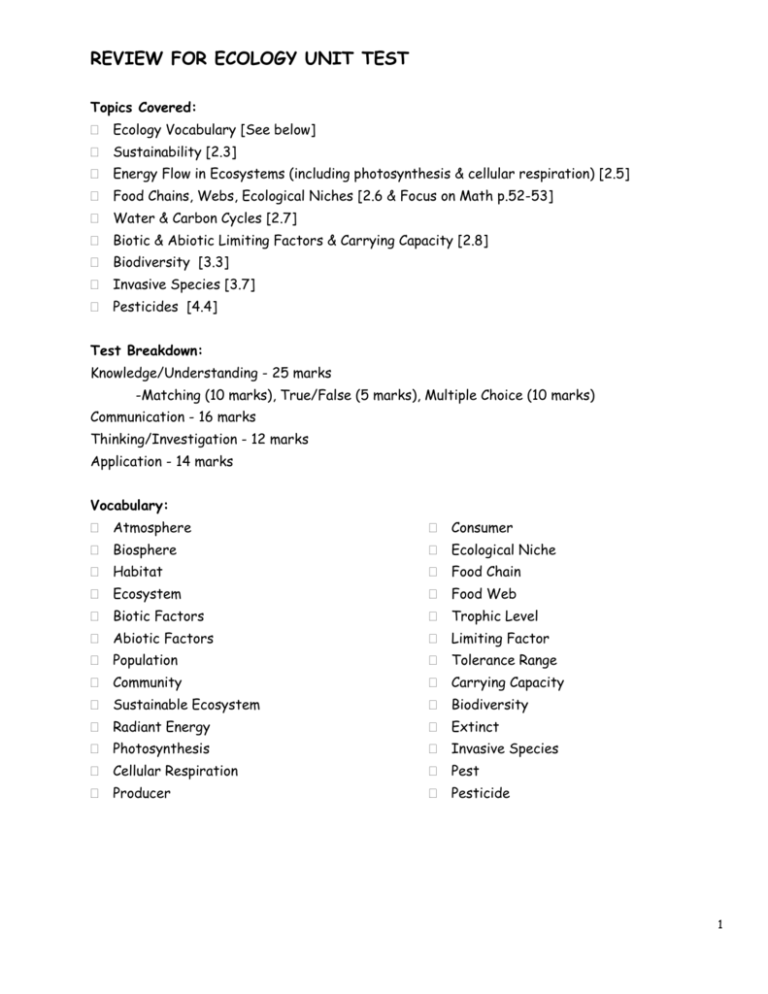
REVIEW FOR ECOLOGY UNIT TEST Topics Covered: Ecology Vocabulary [See below] Sustainability [2.3] Energy Flow in Ecosystems (including photosynthesis & cellular respiration) [2.5] Food Chains, Webs, Ecological Niches [2.6 & Focus on Math p.52-53] Water & Carbon Cycles [2.7] Biotic & Abiotic Limiting Factors & Carrying Capacity [2.8] Biodiversity [3.3] Invasive Species [3.7] Pesticides [4.4] Test Breakdown: Knowledge/Understanding - 25 marks -Matching (10 marks), True/False (5 marks), Multiple Choice (10 marks) Communication - 16 marks Thinking/Investigation - 12 marks Application - 14 marks Vocabulary: Atmosphere Consumer Biosphere Ecological Niche Habitat Food Chain Ecosystem Food Web Biotic Factors Trophic Level Abiotic Factors Limiting Factor Population Tolerance Range Community Carrying Capacity Sustainable Ecosystem Biodiversity Radiant Energy Extinct Photosynthesis Invasive Species Cellular Respiration Pest Producer Pesticide 1 Review Questions: 1. a) Explain how the extinction of one species can affect the food chain in an ecosystem? b) Explain why the extinction of a species in a jungle ecosystem would have less impact on the food chain than the extinction of a species in a tundra ecosystem. (p. 89) 2. Consider the following food web: grass moose wolves crows coyotes Table 1. Consequences of removing the wolf population from the food web. Population Increase or decrease? Explanation affected Coyote Moose Grass Crow 3. _____________________What is the source of energy for organisms on Earth? (p. 38) 4. _____________________ How much of the Sun’s energy warms the surface of the Earth? 5. _____________________ How much of the Sun’s energy is actually used by green plants to make food? 6. _____________________ How much of the Sun’s energy is reflected by clouds or the Earth’s surface? 2 7. Table 2. Energy transfer in food chains. (p. 44) Energy level Producer, primary Plant, herbivore, or Most energy, lesser consumer, carnivore? energy, or least or secondary consumer? energy? (p. 24.) 3rd tropic level 2nd tropic level 1st tropic level 8. Plants undergo photosynthesis: CO2 + H2O + sunlight carbon dioxide Plants and animals undergo C6H12O6 cell respiration: sugar water + O2 oxygen C6H12O6 + sugar CO2 carbon dioxide + O2 oxygen H2O + energy water Explain how the processes of photosynthesis and cell respiration are considered to be “complimentary”. (p. 40) 9. Carbon dioxide (CO2) is the form of carbon in the atmosphere. How is carbon dioxide released into the atmosphere? (p. 50) 10. Oil and gas are other sources of organic matter, containing carbon. How is oil and gas formed? (p. 50) 3 11. Humans have cut down trees to use the land for farming or building cities. As a result, what has been happening to the oxygen levels and carbon dioxide levels in the atmosphere? (p. 51) 12. __________________________ What is the term for chemicals designed to kill pests? (p. 139) 13. Describe three ways that pesticides are beneficial. (p. 139) 14. Table 3. Biotic and abiotic limiting factors of population size. (p. 54-56) Factor Two factors that cause a Two factors that cause a population to increase population to decrease Abiotic (non-living) Biotic (living) 15. Human interference often causes ecosystems to change. Provide an example of how human interference has caused: a. an increase in the population of a species. b. a decrease in the population of a species. c. an increase to the amount of carbon that enters the atmosphere. 16. Draw and label a diagram that shows the flow of water in the water cycle. (p. 49) 4



